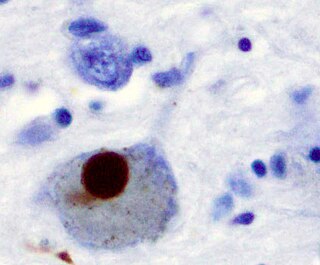
Dementia manifests as a set of related symptoms, which usually surface when the brain is damaged by injury or disease. The symptoms involve progressive impairments in memory, thinking, and behavior, which negatively impact a person's ability to function and carry out everyday activities. Aside from memory impairment and a disruption in thought patterns, the most common symptoms include emotional problems, difficulties with language, and decreased motivation. The symptoms may be described as occurring in a continuum over several stages. Dementia is not a disorder of consciousness, as that is not usually affected. It ultimately has a significant effect on the individual, caregivers, and relationships in general.

Parkinsonism is a clinical syndrome characterized by tremor, bradykinesia, rigidity and postural instability. These are the four motor symptoms found in Parkinson's disease (PD), after which it is named, dementia with Lewy bodies (DLB), Parkinson's disease dementia (PDD), and many other conditions. A wide range of causes may lead to this set of symptoms, including neurodegenerative conditions, drugs, toxins, metabolic diseases and neurological conditions other than PD.

Dementia with Lewy bodies (DLB) is a type of dementia characterized by changes in sleep, behavior, cognition, movement, and regulation of automatic bodily functions. Memory loss is not always an early symptom. The disease worsens over time and is usually diagnosed when cognitive impairment interferes with normal daily functioning. Together with Parkinson's disease dementia, DLB is one of the two Lewy body dementias. It is a common form of dementia, but the prevalence is not known accurately and many diagnoses are missed. The disease was first described by Kenji Kosaka in 1976.
Lewy body dementias are two similar and common subtypes of dementia—dementia with Lewy bodies (DLB) and Parkinson's disease dementia (PDD). Both are characterized by changes in thinking, movement, behavior, and mood. The two conditions have similar features and may have similar causes, and are believed to belong on a spectrum of Lewy body disease that includes Parkinson's disease. As of 2014, they were more often misdiagnosed than any other common dementia.

Rapid eye movement sleep behavior disorder or REM behavior disorder (RBD) is a sleep disorder in which people act out their dreams. It involves abnormal behavior during the sleep phase with rapid eye movement (REM) sleep. The major feature of RBD is loss of muscle atonia during otherwise intact REM sleep. The loss of motor inhibition leads to sleep behaviors ranging from simple limb twitches to more complex integrated movements that can be violent or result in injury to either the individual or their bedmates. RBD is a very strong predictor of progression to a synucleinopathy. Melatonin is useful in the treatment of RBD. RBD was first described in 1986.

Lewy bodies are the inclusion bodies – abnormal aggregations of protein – that develop inside nerve cells affected by Parkinson's disease (PD), the Lewy body dementias, and some other disorders. They are also seen in cases of multiple system atrophy, particularly the parkinsonian variant (MSA-P).
Parkinson-plus syndromes (PPS) is a group of neurodegenerative diseases featuring the classical features of Parkinson's disease with additional features that distinguish them from simple idiopathic Parkinson's disease (PD). Parkinson-plus syndromes are either inherited genetically or occur sporadically.

Parkinson's disease (PD), or simply Parkinson's, is a long-term degenerative disorder of the central nervous system that mainly affects the motor system. The symptoms usually emerge slowly, and as the disease worsens, non-motor symptoms become more common. The most obvious early symptoms are tremor, rigidity, slowness of movement, and difficulty with walking. Cognitive and behavioral problems may also occur with depression, anxiety, and apathy occurring in many people with PD. Parkinson's disease dementia becomes common in the advanced stages of the disease. Those with Parkinson's can also have problems with their sleep and sensory systems. The motor symptoms of the disease result from the death of cells in the substantia nigra, a region of the midbrain, leading to a dopamine deficit. The cause of this cell death is poorly understood, but involves the build-up of misfolded proteins into Lewy bodies in the neurons. Collectively, the main motor symptoms are also known as parkinsonism or a parkinsonian syndrome.

Signs and symptoms of Parkinson's disease are varied. Parkinson's disease affects movement, producing motor symptoms. Non-motor symptoms, which include dysautonomia, cognitive and neurobehavioral problems, and sensory and sleep difficulties, are also common. When other diseases mimic Parkinson's disease, they are categorized as parkinsonism.
Yokukansan is one of herbal recipes of traditional Chinese medicine using widely in Eastern Asian countries including China, Taiwan, North and South Koreas and Japan. There are some classical text books describing YKS for example 『保嬰金鏡録』, 『保嬰撮要』 by 薛鎧 wrote that "愚製(my original)" in his book, so that 銭乙 may be the originator of this recipe. Yokukansan (YKS) contains an exactly measured mixture of dried herbs, 3g of Atractylodes macrocephala macrocephala Koidz. in China or 4 g of Atractylodes lanceae rhizoma (蒼朮) in Japan, 4 g of Poria (伏苓), 3 g of Cnidii rhizoma (川芎), 3 g of Angelicae radix (当帰), 2 g of Bupleuri radix (柴胡), 1.5 g of Glycyrrhizae radix (甘草), and 3 g of Uncariae uncis cum ramulus (釣藤鈎).

AFDX-384 (BIBN-161) is a drug which acts as a selective antagonist of the muscarinic acetylcholine receptors, with selectivity for the M2 and M4 subtypes. It is used mainly for mapping the distribution of M2 and M4 muscarinic receptors in the brain, and studying their involvement in the development and treatment of dementia and schizophrenia.
Kenji Kosaka is a Japanese psychiatrist, known for his pioneer research on Dementia with Lewy bodies (DLB), which he first described.

Synucleinopathies are neurodegenerative diseases characterised by the abnormal accumulation of aggregates of alpha-synuclein protein in neurons, nerve fibres or glial cells. There are three main types of synucleinopathy: Parkinson's disease (PD), dementia with Lewy bodies (DLB), and multiple system atrophy (MSA). Other rare disorders, such as various neuroaxonal dystrophies, also have α-synuclein pathologies. Additionally, autopsy studies have shown that around 6% of sporadic Alzheimer's Disease exhibit α-synuclein positive Lewy pathology, and are sub-classed as Alzheimer's Disease with Amygdalar Restricted Lewy Bodies (AD/ALB).
Visual selective attention is a brain function that controls the processing of retinal input based on whether it is relevant or important. It selects particular representations to enter perceptual awareness and therefore guide behaviour. Through this process, less relevant information is suppressed.
Parkinson's disease dementia (PDD) is dementia that is associated with Parkinson's disease (PD). Together with dementia with Lewy bodies (DLB), it is one of the Lewy body dementias characterized by abnormal deposits of Lewy bodies in the brain.
The Dementia with Lewy Bodies Consortium is an international multidisciplinary collaboration of researchers interested in the dementia with Lewy bodies. It first convened in Newcastle upon Tyne, England, in October 1995. Between 1995 and 2005, it issued three DLBC Consensus Reports on dementia with Lewy bodies.
Corticobasal syndrome (CBS) is a rare, progressive atypical Parkinsonism syndrome and is a tauopathy related to frontotemporal dementia. CBS is typically caused by the deposit of tau proteins forming in different areas of the brain.
The REM Sleep Behavior Disorder Single-Question Screen (RBD1Q), is a one-question, screening question for dream enactment behaviors associated with the parasomnia REM sleep behavior disorder (RBD). It screens for RBD with a simple yes/no response.
Ian G. McKeith is a professor of Old Age Psychiatry at Newcastle University in Newcastle upon Tyne in the North-East of England. He is a Fellow of the Royal Society of Biology and a Fellow of the Academy of Medical Sciences.
The Lewy Body Dementia Association (LBDA) is a US nonprofit organization based in Lilburn, Georgia, and "dedicated to raising awareness of the Lewy body dementias (LBD), supporting people with LBD, their families and caregivers and promoting scientific advances".








